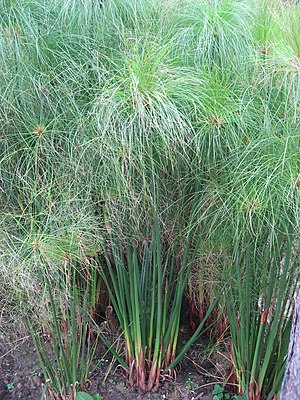Real papyrus
| Real papyrus | ||||||||||||
|---|---|---|---|---|---|---|---|---|---|---|---|---|

Real papyrus ( Cyperus papyrus ) - habitus |
||||||||||||
| Systematics | ||||||||||||
|
||||||||||||
| Scientific name | ||||||||||||
| Cyperus papyrus | ||||||||||||
| L. |
The real papyrus ( Cyperus papyrus ) is a species of the genus of the sedge ( Cyperus ) in the family of the sour grass plants (Cyperaceae). Plant parts of this kind were used in ancient times as raw material for the production of papyrus and reed boats.
description
The real papyrus is a perennial , herbaceous plant that forms rhizomes . The stalk is rounded and triangular and reaches heights of between 300 and 500 centimeters. It has a diameter of 15 to 45 millimeters at the base and is bald. The leaves are spiteless .
The entire inflorescence resembles a double umbel , with the 40 to 100 first-order rays being 10 to 30 centimeters long and pendulous to arched, the second-order rays being 8 to 20 centimeters long. There are four to ten upright bracts of the first order, which are V-shaped keeled, 3 to 8 inches long and between 4 and 15 millimeters wide. The two to five bracts of the second order are 1.5 to 16 centimeters long (on average 4 centimeters). The partial inflorescences are cylindrical spikes 10 to 20 mm long and 6 to 10 mm wide.
The 6 to 30 spikelets per ear are slightly compressed and linear or more or less square. They are between 6 and 10 millimeters wide and have a diameter of 0.8 to 1 mm. The spikelet axes (Rhachillae) do not disintegrate at maturity, they divide laterally and are 0.3 to 0.4 millimeters wide winged. The 6 to 16 flower scales per spikelet are reddish with a five-ribbed, green central part, white to transparent at the edges. Their shape is oval to elliptical, they are 1.8 to 2.2 mm long and 1.2 to 1.5 mm wide. The tip is pointed to blunt.
The individual flowers carry 0.1 to 1 millimeter long anthers , these have a reddish awl-like appendage with a bristly tip that is between 0.2 and 0.5 millimeters long. The stylus is 0.2 to 0.4 millimeters long.
The nuts are dull brown, sessile, oblong and between 0.8 and 1 millimeter long and about 0.4 millimeters wide. They have a grainy surface.
The number of chromosomes is 2n = about 100.
distribution

The real papyrus thrives on river banks and on marshes. Originally the species is distributed in southern Europe, southwest Asia and Africa, today especially in the Sudd and the Okavango Delta . In Europe there are only a few natural occurrences in the vicinity of Syracuse in Sicily ( Anapo , Fiumefreddo di Sicilia ).
Larger neophytic occurrences are found in Florida in the United States and in Central America.
Systematics
One can distinguish the following subspecies :
- Cyperus papyrus subsp. madagascariensis (Willd.) Kük. : It occurs in Tanzania, Madagascar , Mauritius and Réunion.
- Cyperus papyrus subsp. nyassicus (Chiov.) Kük. : It occurs in Malawi and southern Africa.
- Cyperus papyrus subsp. papyrus : It occurs from Egypt to tropical and southern Africa and also in Sicily.
- Cyperus papyrus subsp. zairensis (Chiov.) Kük. : It occurs from the Republic of the Congo and the Democratic Republic of the Congo to Angola .
use
The papyrus achieved great fame because it was used thousands of years ago to produce papyrus as a writing material. To do this, the pulp of the stem of this plant was cut into strips, placed crosswise on top of one another and pressed. The emerging adhesive sap connects the medullary strips.
In ancient Egypt , probably as early as the 3rd millennium BC. The first papyri were made as writing material. Production was probably already under royal monopoly during the Ptolemaic period .
Papyrus was also used in ancient Egypt as a building material for ceremonial boats. Bas-reliefs from the 4th dynasty show men cutting papyrus to build reed boats . In Ethiopia, on Lake Tana , canoes are still made from papyrus today.
literature
- Gordon C. Tucker, Brian G. Marcks, J. Richard Carter: Cyperus papyrus . In: Flora of North America . tape 23 . Oxford University Press, Oxford 2003, ISBN 0-19-515207-7 , pp. 173 (in English, online [accessed November 24, 2008]).
- Karl Dziatzko : Byblos 4 . In: Paulys Realencyclopadie der classischen Antiquity Science (RE). Volume III, 1, Stuttgart 1897, Col. 1100–1104 (for use in ancient times).
Individual evidence
- ^ Tropicos. [1]
- ↑ a b c d e f Rafaël Govaerts (Ed.): Cyperus papyrus. In: World Checklist of Selected Plant Families (WCSP) - The Board of Trustees of the Royal Botanic Gardens, Kew . Retrieved October 26, 2016.
- ↑ Jörg Sieger: On the technique of writing. Retrieved November 24, 2008 .
- ↑ Rosemarie Drenkhahn: Papyrus . In: Wolfgang Helck , Wolfhart Westendorf (Hrsg.): Lexikon der Ägyptologie . tape IV . Wiesbaden 1982, Sp. 667-670 .
- ^ Steve Vinson: Egyptian Boats and Ships . Shire Books, Oxford 2008, ISBN 978-0-7478-0222-8 .
- ^ Vera Krömer: A canoe trip in Ethiopia . In: Kanu-Magazin . October 2004 ( online [accessed November 24, 2008]).
Web links
- Thomas Meyer: Data sheet with identification key and photos at Flora-de: Flora von Deutschland (old name of the website: Flowers in Swabia )
- Cyperus papyrus inthe IUCN 2013 Red List of Threatened Species . Posted by: Kumar, B., 2011. Retrieved April 11, 2014.



